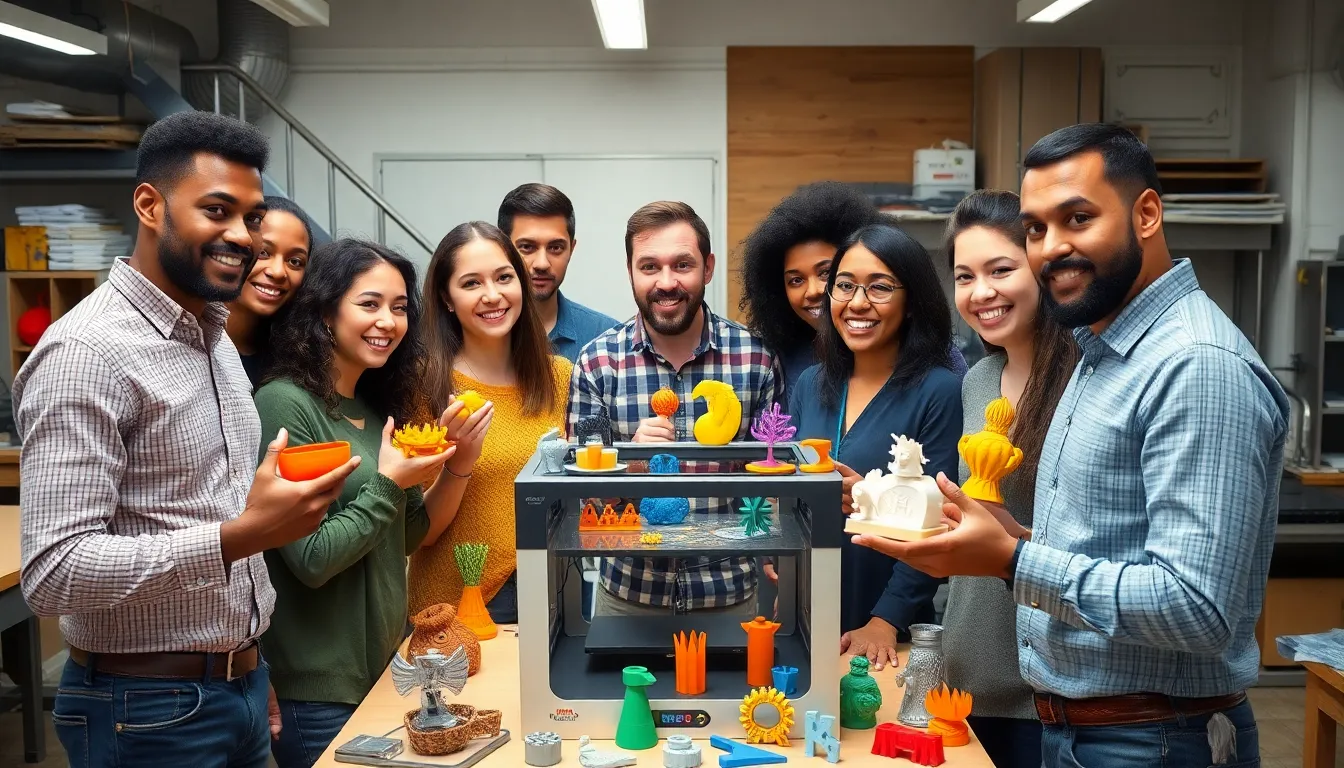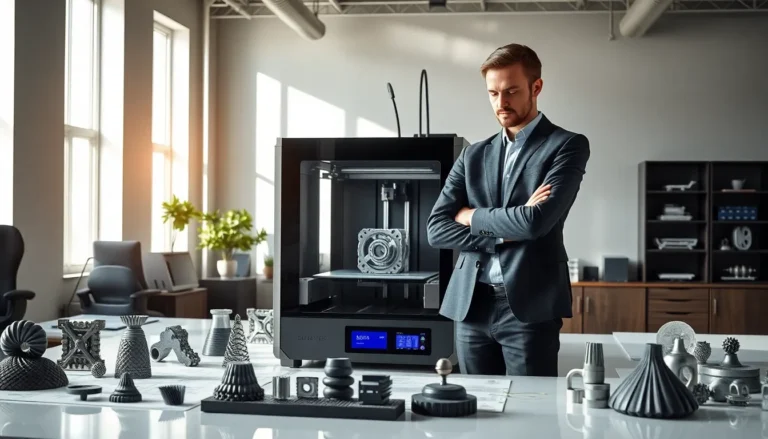Table of Contents
ToggleImagine a world where your wildest design dreams come true, and you don’t need a magic wand to make it happen. Enter 3D printing customization, the superhero of the manufacturing realm. Gone are the days of one-size-fits-all products that leave you feeling like a square peg in a round hole. With 3D printing, individuals and businesses can transform their unique ideas into tangible reality, all while having a little fun along the way.
Whether it’s a quirky phone case that screams personality or a custom part that fits your project like a glove, 3D printing opens the door to endless possibilities. It’s not just about making things; it’s about making things that are uniquely you. So buckle up and get ready to explore how this innovative technology is reshaping creativity and personalization in ways that’ll leave you grinning from ear to ear.
Overview of 3D Printing Customization
3D printing customization revolutionizes manufacturing by enabling personalized creations. This technology shifts focus from standard products to unique designs tailored to individual needs. Individuals often create custom phone cases, bespoke jewelry, or specific components for projects utilizing various materials and techniques.
Focusing on user experience, this customization allows designers to test ideas quickly. By altering digital models, creators achieve precise specifications without significant expense. Many manufacturers adopt 3D printing to streamline production processes, lowering costs while enhancing creativity.
Industries benefit from this innovation through rapid prototyping. Designers can modify designs based on feedback, making adjustments efficiently. This approach speeds up the development stage and improves product relevance in the market.
Custom toys illustrate another application of 3D printing. Parents can personalize toys to cater to their children’s preferences. Individuals design everything from characters to colors, fostering engagement and emotional connections.
Businesses increasingly leverage 3D printing for production flexibility. Companies can produce small batches of diverse products without investing in costly molds. This adaptability supports niche markets and custom orders effectively.
As technology advances, accessibility to 3D printing customization grows. Software tools simplify complex design processes, empowering hobbyists and professionals alike. Community-driven platforms encourage collaboration and sharing of custom designs, nurturing innovation.
The environmental impact of customized 3D printing demonstrates its potential sustainability. It reduces waste through additive manufacturing, using materials more efficiently. Consequently, this approach plays a vital role in promoting eco-friendly practices within the industry.
Benefits of 3D Printing Customization

3D printing customization offers numerous advantages that enhance user experience and product potential.
Enhanced Creativity
Enhanced creativity stands as a primary benefit of 3D printing customization. Users express their unique ideas without constraints, leading to innovative designs. Designers can swiftly iterate on concepts, transforming initial sketches into tangible products. This flexibility allows for exploration of unconventional shapes and structures. As a result, artists and engineers push boundaries, creating custom pieces that reflect personal styles or specific project requirements. Access to versatile materials enhances this creative process, allowing for experimentation with texture, color, and form. Industry professionals recognize the significance of such creativity in differentiating their offerings in competitive markets.
Improved Functionality
Improved functionality is another pivotal benefit of 3D printing customization. Manufacturers produce tailored components that precisely match intended uses. This customization drives efficiency, aligning products closely with user expectations. Adjustments based on real-time feedback lead to enhanced product designs, directly addressing consumer needs. Many industries, such as healthcare, thrive on this functionality, crafting custom prosthetics and dental implants. Personalized solutions cater to individual anatomical requirements, resulting in superior fit and comfort. Such advancements not only boost user satisfaction but also set new standards for product effectiveness and innovation.
Applications of 3D Printing Customization
3D printing customization finds applications across various industries, enhancing product design and user satisfaction.
Healthcare Industry
3D printing revolutionizes the healthcare sector through custom prosthetics and dental implants. Innovations allow for tailored solutions that improve patient comfort. Personalized surgical models enhance pre-operative planning, enabling more precise procedures. Devices created through this technology often align better with individual anatomical needs. By fostering enhanced user satisfaction, healthcare professionals find greater success in meeting their patients’ unique requirements.
Automotive Sector
3D printing customization transforms the automotive industry by enabling rapid prototyping and production. Manufacturers can create unique components, reducing lead times significantly. This technology supports small-scale production of specialized parts, breaking the cycle of generic design. Custom modifications frequently enhance vehicle performance, catering to diverse consumer preferences. Cost-effective manufacturing solutions result in lower production costs while maintaining high-quality standards.
Consumer Products
Customization with 3D printing reshapes the consumer products landscape through personalized items. Customers can design unique phone cases, home decor, and toys that reflect their individual tastes. This ability fosters creativity and engagement, making products more meaningful. Companies benefit from lower inventory costs, as they produce only what’s demanded. Enhanced market responsiveness keeps brands ahead in a competitive environment.
Challenges in 3D Printing Customization
3D printing customization faces several challenges that can hinder its widespread adoption and effectiveness. Addressing these obstacles is essential for maximizing the benefits of this innovative technology.
Technical Limitations
Technical limitations can significantly impact the capabilities of 3D printing. Software compatibility issues may arise, complicating the design process. Limitations in material choices restrict versatility, as not all designs can be produced with every type of printer. Print speed often remains an issue; slower printers may not meet tight deadlines. Resolution constraints can lead to less detailed finishes, especially in complex designs. Additionally, equipment costs can be prohibitive for small businesses or individual users, limiting access to advanced technologies.
Cost Considerations
Cost considerations heavily influence decisions around 3D printing customization. Initial investment expenses for reliable 3D printers can discourage small businesses from entering the market. Material costs also add to overall expenditure; specialized materials often come with higher price tags. Moreover, the cost of maintaining and operating 3D printers can accumulate, especially with frequent use. Custom designs that require extensive prototyping can lead to rising costs if iterations are numerous. Companies must carefully evaluate these financial implications to determine the viability of adopting 3D printing techniques in their production processes.
Future Trends in 3D Printing Customization
Advancement in materials is shaping the future of 3D printing customization. Innovative materials such as bioplastics and enhanced metals offer greater flexibility and durability. This evolution allows for the creation of more intricate and high-performance components tailored to specific applications.
Integration with artificial intelligence is enhancing design capabilities. AI algorithms enable quicker generation of design variations based on user preferences and functional requirements. Designers leverage this technology to streamline workflows and optimize designs for performance and manufacturability.
Collaborative platforms are transforming the way users engage with 3D printing. Online communities facilitate shared design ideas, fostering collaboration and inspiring creativity among users. This social aspect creates an ecosystem where users openly exchange tips and resources, making customization more accessible.
Customization software continues to evolve, featuring user-friendly interfaces and advanced functionalities. Such tools simplify complex design processes for individuals with varying skill levels. By empowering more users to experiment with designs, the potential for innovation expands exponentially.
Increased interest in sustainability is driving eco-friendly practices in 3D printing. Companies are investing in sustainable materials and recycling methods to minimize waste. This trend aligns with global initiatives focused on reducing environmental impacts and promoting responsible production methods.
Adoption of 3D printing in education is set to rise. Institutions are integrating 3D printing into curricula, teaching students about design and manufacturing. This trend fosters creativity and equips the next generation with relevant skills for an evolving job market.
Overall, future trends in 3D printing customization highlight a shift towards more accessible, sustainable, and innovative solutions. The combination of technological advancements, collaborative efforts, and educational initiatives sets the stage for a vibrant landscape in custom manufacturing.
3D printing customization stands at the forefront of a manufacturing revolution. Its ability to transform ideas into tangible products fosters creativity and innovation across various sectors. As technology continues to evolve accessibility increases and the potential for personalized solutions expands.
The shift towards sustainable practices coupled with advancements in materials and design software promises a bright future for this industry. Overcoming existing challenges will be essential for maximizing the benefits of 3D printing. Embracing this technology not only enhances user experience but also paves the way for a more personalized and eco-friendly manufacturing landscape.




